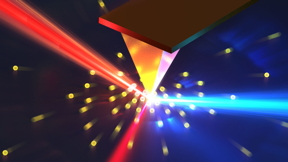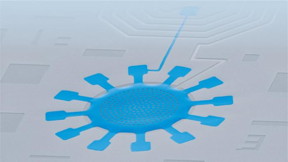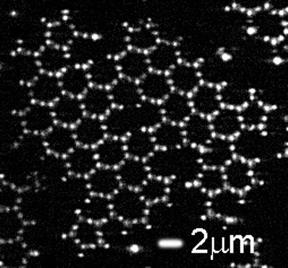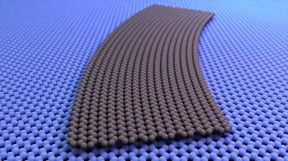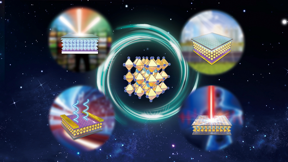Home > Press > Shedding light on unique conduction mechanisms in a new type of perovskite oxide
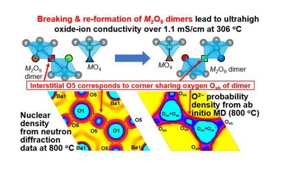 |
| The top figure shows the snapshot for the oxide-ion migration. The red and green oxide ions move by breaking and reforming of M2O9 dimers, which enables fast oxide-ion diffusion where the M cation is Nb5+ or Mo6+. The neutron scattering length density distribution from neutron diffraction data at 800 ℃ in the bottom left figure agrees with the time- and space-averaged probability density distribution of oxide ions from ab initio molecular dynamics simulations in the bottom right figure. The interstitial O5 atom in the bottom left figure corresponds to the corner-sharing oxygen atom (Osh in the bottom right figure and squares in the top figure). CREDIT Chemistry of Materials |
Abstract:
The remarkable proton and oxide-ion (dual-ion) conductivities of hexagonal perovskite-related oxide Ba7Nb3.8Mo1.2O20.1 are promising for next-generation electrochemical devices, as reported by scientists at Tokyo Tech. The unique ion-transport mechanisms they unveiled will hopefully pave the way for better dual-ion conductors, which could play an essential role in tomorrow’s clean energy technologies.
Shedding light on unique conduction mechanisms in a new type of perovskite oxide
Tokyo, Japan | Posted on November 17th, 2023Clean energy technologies are the cornerstone of sustainable societies, and solid-oxide fuel cells (SOFCs) and proton ceramic fuel cells (PCFCs) are among the most promising types of electrochemical devices for green power generation. These devices, however, still face challenges that hinder their development and adoption.
Ideally, SOFCs should be operated at low temperatures to prevent unwanted chemical reactions from degrading their constituent materials. Unfortunately, most known oxide-ion conductors, a key component of SOFCs, only exhibit decent ionic conductivity at elevated temperatures. As for PCFCs, not only are they chemically unstable under carbon dioxide atmospheres, but they also require energy-intensive, high-temperature processing steps during manufacture.
Fortunately, there is a type of material that can solve these problems by combining the benefits of both SOFCs and PCFCs: dual-ion conductors. By supporting the diffusion of both protons and oxide ions, dual-ion conductors can realize high total conductivity at lower temperatures and improve the performance of electrochemical devices. Although some perovskite-related dual-ion conducting materials such as Ba7Nb4MoO20 have been reported, their conductivities are not high enough for practical applications, and their underlying conducting mechanisms are not well understood.
Against this backdrop, a research team led by Professor Masatomo Yashima from Tokyo Institute of Technology, Japan, decided to investigate the conductivity of materials similar to 7Nb4MoO20 but with a higher Mo fraction (that is, Ba7Nb4-xMo1+xO20+x/2). Their latest study, which was conducted in collaboration with the Australian Nuclear Science and Technology Organisation (ANSTO), the High Energy Accelerator Research Organization (KEK), and Tohoku University, was published in Chemistry of Materials.
After screening various Ba7Nb4-xMo1+xO20+x/2 compositions, the team found that Ba7Nb3.8Mo1.2O20.1 had remarkable proton and oxide-ion conductivities. "Ba7Nb3.8Mo1.2O20.1 exhibited bulk conductivities of 11 mS/cm at 537 ℃ under wet air and 10 mS/cm at 593 ℃ under dry air. Total direct current conductivity at 400 ℃ in wet air of Ba7Nb3.8Mo1.2O20.1 was 13 times higher than that of Ba7Nb4MoO20, and the bulk conductivity in dry air at 306 ℃ is 175 times higher than that of the conventional yttria-stabilized zirconia (YSZ)," highlights Prof. Yashima.
Next, the researchers sought to shed light on the underlying mechanisms behind these high conductivity values. To this end, they conducted ab initio molecular dynamics (AIMD) simulations, neutron diffraction experiments, and neutron scattering length density analyses. These techniques enabled them to study the structure of Ba7Nb3.8Mo1.2O20.1 in greater detail and determine what makes it special as a dual-ion conductor.
Interestingly, the team found that the high oxide-ion conductivity of Ba7Nb3.8Mo1.2O20.1 originates from a unique phenomenon (Figure). It turns out that adjacent MO5 monomers in Ba7Nb3.8Mo1.2O20.1 can form M2O9 dimers by sharing an oxygen atom on one of their corners (M = Nb or Mo cation). The breaking and reforming of these dimers gives rise to ultrafast oxide-ion movement in a manner analogous to a long line of people relaying buckets of water (oxide ions) from one person to the next. Furthermore, the AIMD simulations revealed that the observed high proton conduction was due to efficient proton migration in the hexagonal close-packed BaO3 layers in the material.
Taken together, the results of this study highlight the potential of perovskite-related dual-ion conductors and could serve as guidelines for the rational design of these materials. "The present findings of high conductivities and unique ion migration mechanisms in Ba7Nb3.8Mo1.2O20.1 will help the development of science and engineering of oxide-ion, proton, and dual-ion conductors," concludes a hopeful Prof. Yashima.
We hope further research leads us to even better conducting materials for next-generation energy technologies.
####
About Tokyo Institute of Technology
Tokyo Tech stands at the forefront of research and higher education as the leading university
for science and technology in Japan. Tokyo Tech researchers excel in fields ranging from
materials science to biology, computer science, and physics. Founded in 1881, Tokyo Tech
hosts over 10,000 undergraduate and graduate students per year, who develop into scientific
leaders and some of the most sought-after engineers in industry. Embodying the Japanese
philosophy of “monotsukuri,” meaning “technical ingenuity and innovation,” the Tokyo Tech
community strives to contribute to society through high-impact research.
https://www.titech.ac.jp/english/
For more information, please click here
Contacts:
Emiko Kawaguchi
Tokyo Institute of Technology
Office: +81-3-5734-2975
Copyright © Tokyo Institute of Technology
If you have a comment, please Contact us.Issuers of news releases, not 7th Wave, Inc. or Nanotechnology Now, are solely responsible for the accuracy of the content.
| Related Links |
| Related News Press |
News and information
![]() Inverted perovskite solar cell breaks 25% efficiency record: Researchers improve cell efficiency using a combination of molecules to address different November 17th, 2023
Inverted perovskite solar cell breaks 25% efficiency record: Researchers improve cell efficiency using a combination of molecules to address different November 17th, 2023
![]() Night-time radiative warming using the atmosphere November 17th, 2023
Night-time radiative warming using the atmosphere November 17th, 2023
![]() A new kind of magnetism November 17th, 2023
A new kind of magnetism November 17th, 2023
Perovskites
![]() Inverted perovskite solar cell breaks 25% efficiency record: Researchers improve cell efficiency using a combination of molecules to address different November 17th, 2023
Inverted perovskite solar cell breaks 25% efficiency record: Researchers improve cell efficiency using a combination of molecules to address different November 17th, 2023
Possible Futures
![]() Silver nanoparticles: guaranteeing antimicrobial safe-tea November 17th, 2023
Silver nanoparticles: guaranteeing antimicrobial safe-tea November 17th, 2023
![]() Three-pronged approach discerns qualities of quantum spin liquids November 17th, 2023
Three-pronged approach discerns qualities of quantum spin liquids November 17th, 2023
![]() Inverted perovskite solar cell breaks 25% efficiency record: Researchers improve cell efficiency using a combination of molecules to address different November 17th, 2023
Inverted perovskite solar cell breaks 25% efficiency record: Researchers improve cell efficiency using a combination of molecules to address different November 17th, 2023
![]() Night-time radiative warming using the atmosphere November 17th, 2023
Night-time radiative warming using the atmosphere November 17th, 2023
Discoveries
![]() Inverted perovskite solar cell breaks 25% efficiency record: Researchers improve cell efficiency using a combination of molecules to address different November 17th, 2023
Inverted perovskite solar cell breaks 25% efficiency record: Researchers improve cell efficiency using a combination of molecules to address different November 17th, 2023
![]() Night-time radiative warming using the atmosphere November 17th, 2023
Night-time radiative warming using the atmosphere November 17th, 2023
![]() A new kind of magnetism November 17th, 2023
A new kind of magnetism November 17th, 2023
Announcements
![]() Inverted perovskite solar cell breaks 25% efficiency record: Researchers improve cell efficiency using a combination of molecules to address different November 17th, 2023
Inverted perovskite solar cell breaks 25% efficiency record: Researchers improve cell efficiency using a combination of molecules to address different November 17th, 2023
![]() Night-time radiative warming using the atmosphere November 17th, 2023
Night-time radiative warming using the atmosphere November 17th, 2023
![]() A new kind of magnetism November 17th, 2023
A new kind of magnetism November 17th, 2023
Interviews/Book Reviews/Essays/Reports/Podcasts/Journals/White papers/Posters
![]() Inverted perovskite solar cell breaks 25% efficiency record: Researchers improve cell efficiency using a combination of molecules to address different November 17th, 2023
Inverted perovskite solar cell breaks 25% efficiency record: Researchers improve cell efficiency using a combination of molecules to address different November 17th, 2023
![]() Night-time radiative warming using the atmosphere November 17th, 2023
Night-time radiative warming using the atmosphere November 17th, 2023
![]() A new kind of magnetism November 17th, 2023
A new kind of magnetism November 17th, 2023
Energy
![]() Inverted perovskite solar cell breaks 25% efficiency record: Researchers improve cell efficiency using a combination of molecules to address different November 17th, 2023
Inverted perovskite solar cell breaks 25% efficiency record: Researchers improve cell efficiency using a combination of molecules to address different November 17th, 2023
![]() The efficient perovskite cells with a structured anti-reflective layer – another step towards commercialization on a wider scale October 6th, 2023
The efficient perovskite cells with a structured anti-reflective layer – another step towards commercialization on a wider scale October 6th, 2023
![]() Successful morphing of inorganic perovskites without damaging their functional properties October 6th, 2023
Successful morphing of inorganic perovskites without damaging their functional properties October 6th, 2023
![]() A non-covalent bonding experience: Scientists discover new structures for unique hybrid materials by altering their chemical bonds July 21st, 2023
A non-covalent bonding experience: Scientists discover new structures for unique hybrid materials by altering their chemical bonds July 21st, 2023
Research partnerships
![]() Nanoparticle quasicrystal constructed with DNA: The breakthrough opens the way for designing and building more complex structures November 3rd, 2023
Nanoparticle quasicrystal constructed with DNA: The breakthrough opens the way for designing and building more complex structures November 3rd, 2023
![]() Electronic detection of DNA nanoballs enables simple pathogen detection Peer-Reviewed Publication September 8th, 2023
Electronic detection of DNA nanoballs enables simple pathogen detection Peer-Reviewed Publication September 8th, 2023
Solar/Photovoltaic
![]() Inverted perovskite solar cell breaks 25% efficiency record: Researchers improve cell efficiency using a combination of molecules to address different November 17th, 2023
Inverted perovskite solar cell breaks 25% efficiency record: Researchers improve cell efficiency using a combination of molecules to address different November 17th, 2023
![]() Charged “molecular beasts” the basis for new compounds: Researchers at Leipzig University use “aggressive” fragments of molecular ions for chemical synthesis November 3rd, 2023
Charged “molecular beasts” the basis for new compounds: Researchers at Leipzig University use “aggressive” fragments of molecular ions for chemical synthesis November 3rd, 2023
![]() The efficient perovskite cells with a structured anti-reflective layer – another step towards commercialization on a wider scale October 6th, 2023
The efficient perovskite cells with a structured anti-reflective layer – another step towards commercialization on a wider scale October 6th, 2023
![]() A universal HCl-assistant powder-to-powder strategy for preparing lead-free perovskites March 24th, 2023
A universal HCl-assistant powder-to-powder strategy for preparing lead-free perovskites March 24th, 2023
- SEO Powered Content & PR Distribution. Get Amplified Today.
- PlatoData.Network Vertical Generative Ai. Empower Yourself. Access Here.
- PlatoAiStream. Web3 Intelligence. Knowledge Amplified. Access Here.
- PlatoESG. Carbon, CleanTech, Energy, Environment, Solar, Waste Management. Access Here.
- PlatoHealth. Biotech and Clinical Trials Intelligence. Access Here.
- Source: http://www.nanotech-now.com/news.cgi?story_id=57424
- :is
- :not
- :where
- 000
- 1
- 10
- 11
- 13
- 17th
- 21st
- 24th
- 28
- 3rd
- 400
- 6th
- 7th
- 8th
- a
- AC
- accelerator
- accuracy
- address
- adjacent
- Adoption
- AIR
- also
- Although
- among
- an
- analyses
- and
- Another
- applications
- approach
- April
- ARE
- around
- AS
- At
- atom
- Australian
- backdrop
- basis
- BE
- been
- behind
- benefits
- Better
- biology
- both
- Bottom
- Breaking
- breaks
- breakthrough
- Building
- but
- by
- CAN
- candidate
- carbon
- carbon dioxide
- cell
- Cells
- Center
- CGI
- challenges
- chemical
- chemistry
- clean
- clean energy
- click
- cold
- collaboration
- COM
- combination
- combining
- comment
- commercialisation
- commercialization
- complex
- component
- computer
- computer science
- concludes
- conducted
- conducting
- conductivity
- conductor
- constituent
- content
- contribute
- control
- conventional
- corners
- cornerstone
- corresponds
- could
- credit
- Current
- damaging
- data
- deal
- decent
- decided
- del
- density
- Design
- designing
- detail
- Detection
- Determine
- develop
- Development
- Devices
- Diffusion
- direct
- discover
- distribution
- dna
- dry
- due
- during
- dynamics
- Education
- efficiency
- efficient
- Electronic
- elevated
- enabled
- enables
- end
- energy
- Engineering
- Engineers
- enough
- essential
- Ether (ETH)
- Even
- Excel
- exhibit
- exhibited
- experience
- experiments
- Face
- FAST
- Fields
- Figure
- findings
- For
- forefront
- form
- found
- Founded
- fraction
- from
- Fuel
- fuel cells
- functional
- fundamental
- further
- Furthermore
- future
- generation
- gif
- gives
- Global
- graduate
- Graphene
- greater
- Green
- green power
- guidelines
- had
- Have
- help
- helped
- High
- higher
- Higher education
- Highlight
- highlights
- hinder
- hope
- hopeful
- Hopefully
- However
- http
- HTTPS
- Hybrid
- if
- improve
- in
- Inc.
- industry
- information
- ingenuity
- Innovation
- Institute
- International
- international space station
- into
- investigate
- Ionic
- IT
- Japan
- jpg
- July
- Key
- Kind
- known
- lab
- landmark
- latest
- layer
- layers
- leading
- Leads
- Led
- left
- Length
- light
- Line
- links
- Long
- Low
- lower
- MAKES
- manner
- March
- material
- materials
- meaning
- mechanisms
- metal
- migration
- molecular
- more
- most
- move
- movement
- nanotechnology
- Nature
- net
- New
- news
- next
- next-generation
- nicholas
- November
- now
- nuclear
- observed
- october
- of
- on
- ONE
- only
- opens
- operated
- or
- organisation
- organization
- out
- over
- Oxygen
- pave
- peer-reviewed
- People
- per
- performance
- person
- phenomenon
- PHP
- Physics
- plato
- Plato Data Intelligence
- PlatoData
- Play
- please
- Post
- posted
- potential
- power
- Practical
- Practical Applications
- preparing
- present
- press
- Press Release
- prevent
- probability
- probe
- problems
- processing
- Professor
- promising
- protons
- published
- qualities
- Quantum
- ranging
- Rational
- reactions
- realize
- record
- Red
- release
- Releases
- remarkable
- Reported
- require
- research
- researchers
- responsible
- Results
- return
- Revealed
- right
- Rise
- Role
- Save
- Science
- Science and Technology
- scientists
- screening
- Search
- September
- serve
- Share
- sharing
- shed
- should
- Shows
- Signs
- similar
- Simple
- Snapshot
- Society
- solar
- solely
- SOLVE
- some
- sought
- Space
- space station
- special
- Spin
- squares
- stands
- start
- station
- Step
- Steps
- Still
- Strategy
- strives
- structure
- structured
- structures
- Students
- Study
- submit
- such
- Superconductivity
- Supporting
- Sustainability
- sustainable
- tackle
- team
- tech
- techniques
- Technologies
- Technology
- than
- that
- The
- the world
- their
- Them
- There.
- These
- they
- this
- Through
- times
- to
- together
- tokyo
- tools
- top
- Total
- towards
- transitions
- turns
- type
- types
- under
- underlying
- understood
- unfortunately
- unique
- Universal
- university
- unveiled
- unwanted
- us
- use
- using
- Values
- various
- was
- Water
- Wave
- Way..
- WELL
- What
- which
- WHO
- wider
- will
- with
- without
- world
- Yahoo
- year
- you
- zephyrnet













